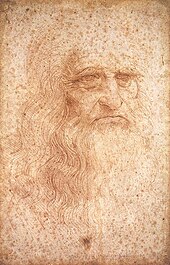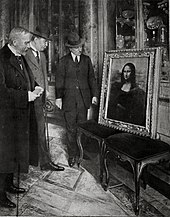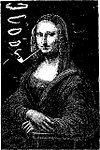Mona Lisa
From Wikipedia, the free encyclopedia
This article is about the painting. For other uses, see Mona Lisa (disambiguation).
| Italian: La Gioconda, French: La Joconde | |
|---|---|
 |
|
| Artist | Leonardo da Vinci |
| Year | c. 1503–1506, perhaps continuing until c. 1517 |
| Type | Oil on poplar |
| Dimensions | 77 cm × 53 cm (30 in × 21 in) |
| Location | Musée du Louvre, Paris |
The painting, thought to be a portrait of Lisa Gherardini, the wife of Francesco del Giocondo, is in oil on a white Lombardy poplar panel, and is believed to have been painted between 1503 and 1506. Leonardo may have continued working on it as late as 1517. It was acquired by King Francis I of France and is now the property of the French Republic, on permanent display at the Louvre Museum in Paris since 1797.[2]
The subject's expression, which is frequently described as enigmatic,[3] the monumentality of the composition, the subtle modeling of forms, and the atmospheric illusionism were novel qualities that have contributed to the continuing fascination and study of the work.[4]
Contents
Title and subject
Main article: Lisa del Giocondo
The title of the painting, which is known in English as Mona Lisa, comes from a description by Renaissance art historian Giorgio Vasari, who wrote "Leonardo undertook to paint, for Francesco del Giocondo, the portrait of Mona Lisa, his wife."[5][6] Mona in Italian is a polite form of address originating as ma donna – similar to Ma’am, Madam, or my lady in English. This became madonna, and its contraction mona. The title of the painting, though traditionally spelled "Mona" (as used by Vasari[5]), is also commonly spelled in modern Italian as Monna Lisa ("mona" being a vulgarity in some Italian dialects) but this is rare in English.[citation needed]Vasari's account of the Mona Lisa comes from his biography of Leonardo published in 1550, 31 years after the artist's death. It has long been the best-known source of information on the provenance of the work and identity of the sitter. Leonardo's assistant Salaì, at his death in 1525, owned a portrait which in his personal papers was named la Gioconda, a painting bequeathed to him by Leonardo.
That Leonardo painted such a work, and its date, were confirmed in 2005 when a scholar at Heidelberg University discovered a marginal note in a 1477 printing of a volume written by the ancient Roman philosopher Cicero. Dated October 1503, the note was written by Leonardo's contemporary Agostino Vespucci. This note likens Leonardo to renowned Greek painter Apelles, who is mentioned in the text, and states that Leonardo was at that time working on a painting of Lisa del Giocondo.[7]
A margin note by Agostino Vespucci (visible at right) discovered in a book at Heidelberg University, dating to 1503, states that Leonardo was working on a portrait of Lisa del Giocondo.
Before that discovery, scholars had developed several alternative views as to the subject of the painting. Some argued that Lisa del Giocondo was the subject of a different portrait, identifying at least four other paintings as the Mona Lisa referred to by Vasari.[13][14] Several other women have been proposed as the subject of the painting.[15] Isabella of Aragon,[16] Cecilia Gallerani,[17] Costanza d'Avalos, Duchess of Francavilla,[15] Isabella d'Este, Pacifica Brandano or Brandino, Isabela Gualanda, Caterina Sforza—even Salaì and Leonardo himself—are all among the list of posited models portrayed in the painting.[18][19] The consensus of art historians in the 21st century is that the painting depicts Lisa del Giocondo; this has long been the traditional opinion.[7]
History
Main article: Leonardo da Vinci
Presumed self-portrait by Leonardo da Vinci, executed in red chalk sometime between 1512 and 1515.
In 1516, Leonardo was invited by King François I to work at the Clos Lucé near the king's castle in Amboise. It is believed that he took the Mona Lisa with him and continued to work after he moved to France.[18] Art historian Carmen C. Bambach has concluded that da Vinci probably continued refining the work until 1516 or 1517.[22]
On his death the painting was inherited, among other works, by his pupil and assistant Salaì.[10] The king bought the painting for 4,000 écus and kept it at Palace of Fontainebleau, where it remained until Louis XIV moved the painting to the Palace of Versailles. After the French Revolution, it was moved to the Louvre, but spent a brief period in the bedroom of Napoleon in the Tuileries Palace.
During the Franco-Prussian War (1870–1871) it was moved from the Louvre to the Brest Arsenal.[23] During World War II, the painting was again removed from the Louvre and taken safely, first to Château d'Amboise, then to the Loc-Dieu Abbey and Château de Chambord, then finally to the Ingres Museum in Montauban.
Theft and vandalism
La Joconde est Retrouvée (Mona Lisa is Found), Le Petit Parisien, Numéro 13559, 13 December 1913
Vacant wall in the Salon Carré, Louvre after the painting was stolen in 1911
The Mona Lisa on display in the Uffizi Gallery, in Florence, 1913. Museum director Giovanni Poggi (right) inspects the painting.
At the time, the painting was believed to be lost forever, and it was two years before the real thief was discovered. Louvre employee Vincenzo Peruggia had stolen it by entering the building during regular hours, hiding in a broom closet and walking out with it hidden under his coat after the museum had closed.[12] Peruggia was an Italian patriot who believed Leonardo's painting should be returned to Italy for display in an Italian museum. Peruggia may have also been motivated by a friend whose copies of the original would significantly rise in value after the painting's theft. A later account suggested Eduardo de Valfierno had been the mastermind of the theft and had commissioned forger Yves Chaudron to create six copies of the painting to be sold in the United States while the location of the original was unclear.[27] But the original remained in Europe and after having kept the Mona Lisa in his apartment for two years, Peruggia grew impatient and was finally caught when he attempted to sell it to the directors of the Uffizi Gallery in Florence; it was exhibited all over Italy and returned to the Louvre in 1913. Peruggia was hailed for his patriotism in Italy and served six months in jail for the crime.[26] Before its theft, the Mona Lisa was not widely known outside the art world. It wasn't until the 1860s that critics began to hail it as a masterwork of Renaissance painting and only within a thin slice of French intelligentsia.[28]
In 1956, part of the painting was damaged when a vandal threw acid at it.[29] On 30 December of that same year, the painting was damaged again when a rock was thrown at it, resulting in the loss of a speck of pigment near the left elbow, which was later restored.[30]
The use of bulletproof glass has shielded the Mona Lisa from more recent attacks. In April 1974 a "lame woman", upset by the museum's policy for disabled people, sprayed red paint at the painting while it was on display at the Tokyo National Museum.[31] On 2 August 2009, a Russian woman, distraught over being denied French citizenship, threw a terra cotta mug or teacup, purchased at the museum, at the painting in the Louvre; the vessel shattered against the glass enclosure.[32][33] In both cases, the painting was undamaged.
Aesthetics
Detail of the background (right side)
The woman sits markedly upright with her arms folded, which is also a sign of her reserved posture. Only her gaze is fixed on the observer and seems to welcome them to this silent communication. Since the brightly lit face is practically framed with various much darker elements (hair, veil, shadows), the observer's attraction to it is brought to even greater extent. The woman appears alive to an unusual measure, which Leonardo achieved by his new method not to draw the outlines (sfumato), "mainly in two features: the corners of the mouth, and the corners of the eyes" (Gombrich).[34] There is no indication of an intimate dialogue between the woman and the observer as is the case in the Portrait of Baldassare Castiglione (Louvre), painted by Raphael about ten years later and undoubtedly influenced by Leonardo's work.
Detail of Lisa's hands, her right hand resting on her left. Leonardo
chose this gesture rather than a wedding ring to depict Lisa as a
virtuous woman and faithful wife.[35]
Mona Lisa has no clearly visible eyebrows or eyelashes. Some researchers claim that it was common at this time for genteel women to pluck these hairs, as they were considered unsightly.[37][38] In 2007, French engineer Pascal Cotte announced that his ultra-high resolution scans of the painting provide evidence that Mona Lisa was originally painted with eyelashes and with visible eyebrows, but that these had gradually disappeared over time, perhaps as a result of overcleaning.[39]
There has been much speculation regarding the painting's model and landscape. For example, that Leonardo probably painted his model faithfully since her beauty is not seen as being among the best, "even when measured by late quattrocento (15th century) or even twenty-first century standards."[40] Some art historians in Eastern art, such as Yukio Yashiro, also argue that the landscape in the background of the picture was influenced by Chinese paintings;[41] however, this thesis has been contested for lack of clear evidence.[41]
A recent research by a geomorphology professor at Urbino University and an artist-photographer revealed astonishing likenesses of the Mona Lisa's landscapes to some views in the Montefeltro region in the Italian provinces of Pesaro, Urbino and Rimini.[42][43]
Conservation
The Mona Lisa has survived for more than 500 years, and an international commission convened in 1952 noted that "the picture is in a remarkable state of preservation."[44] This is partly due to the result of a variety of conservation treatments the painting has undergone. A detailed analysis in 1933 by Madame de Gironde revealed that earlier restorers had "acted with a great deal of restraint."[44] Nevertheless, applications of varnish made to the painting had darkened even by the end of the 16th century, and an aggressive 1809 cleaning and revarnishing removed some of the uppermost portion of the paint layer, resulting in a washed-out appearance to the face of the figure. Despite the treatments, the Mona Lisa has been well cared for throughout its history, and although the panel's warping caused the curators "some worry",[45] the 2004–05 conservation team was optimistic about the future of the work.[44]Poplar panel
At some point in its history, the Mona Lisa was removed from its original frame. The unconstrained poplar panel warped freely with changes in humidity, and as a result, a crack developed near the top of the panel, extending down to the hairline of the figure. In the mid-18th century to early 19th century, two butterfly-shaped walnut braces were inserted into the back of the panel to a depth of about 1/3 the thickness of the panel. This intervention was skillfully executed, and successfully stabilized the crack. Sometime between 1888 and 1905, or perhaps during the picture's theft, the upper brace fell out. A later restorer glued and lined the resulting socket and crack with cloth. The flexible oak frame (added 1951) and cross braces (1970) help to keep the panel from warping further.[citation needed]The picture is currently kept under strict, climate-controlled conditions in its bulletproof glass case. The humidity is maintained at 50% ±10%, and the temperature is maintained between 18 and 21 °C. To compensate for fluctuations in relative humidity, the case is supplemented with a bed of silica gel treated to provide 55% relative humidity.[44]
Frame
Because the Mona Lisa's poplar support expands and contracts with changes in humidity, the picture has experienced some warping. In response to warping and swelling experienced during its storage during World War II, and to prepare the picture for an exhibit to honor the anniversary of Leonardo's 500th birthday, the Mona Lisa was fitted in 1951 with a flexible oak frame with beech crosspieces. This flexible frame, which is used in addition to the decorative frame described below, exerts pressure on the panel to keep it from warping further. In 1970, the beech crosspieces were switched to maple after it was found that the beechwood had been infested with insects. In 2004–2005, a conservation and study team replaced the maple crosspieces with sycamore ones, and an additional metal crosspiece was added for scientific measurement of the panel's warp.The Mona Lisa has had many different decorative frames in its history, owing to changes in taste over the centuries. In 1909, the Comtesse de Béhague gave the portrait its current frame,[46] a Renaissance-era work consistent with the historical period of the Mona Lisa. The edges of the painting have been trimmed at least once in its history to fit the picture into various frames, but no part of the original paint layer has been trimmed.[44]
Cleaning and touch-up
The first and most extensive recorded cleaning, revarnishing, and touch-up of the Mona Lisa was an 1809 wash and revarnishing undertaken by Jean-Marie Hooghstoel, who was responsible for restoration of paintings for the galleries of the Musée Napoléon. The work involved cleaning with spirits, touch-up of colour, and revarnishing the painting. In 1906, Louvre restorer Eugène Denizard performed watercolour retouches on areas of the paint layer disturbed by the crack in the panel. Denizard also retouched the edges of the picture with varnish, to mask areas that had been covered initially by an older frame. In 1913, when the painting was recovered after its theft, Denizard was again called upon to work on the Mona Lisa. Denizard was directed to clean the picture without solvent, and to lightly touch up several scratches to the painting with watercolour. In 1952, the varnish layer over the background in the painting was evened out. After the second 1956 attack, restorer Jean-Gabriel Goulinat was directed to touch up the damage to Mona Lisa's left elbow with watercolour.[44]In 1977, a new insect infestation was discovered in the back of the panel as a result of crosspieces installed to keep the painting from warping. This was treated on the spot with carbon tetrachloride, and later with an ethylene oxide treatment. In 1985, the spot was again treated with carbon tetrachloride as a preventive measure.[44]
Display
Mona Lisa behind glass
Fame
2014: Mona Lisa is among the greatest attractions in the Louvre
US President John F. Kennedy, Madeleine Malraux, André Malraux, Jacqueline Kennedy and Lyndon B. Johnson at the unveiling the Mona Lisa at the National Gallery of Art during its visit to Washington D.C., 8 January 1963.
From December 1962 to March 1963, the French government lent it to the United States to be displayed in New York City and Washington, D.C.[56] In 1974, the painting was exhibited in Tokyo and Moscow.[57]
Value
Before the 1962–63 tour, the painting was assessed for insurance at $100 million. The insurance was not bought. Instead, more was spent on security.[58] As an expensive painting, four paintings sold for more: the Portrait of Adele Bloch-Bauer I by Gustav Klimt, for $135 million, the Woman III by Willem de Kooning sold for $138 million in November 2006, and No. 5, 1948 by Jackson Pollock sold for $140 million in November 2006 and one painting from The Card Players series by Paul Cézanne sold for $250 million.[59] However, adjusted for inflation using the US Consumer Price Index, $100 million in 1962 is $760 million in 2012, making it, in practice, by far the most valued painting in the world.[60]Legacy
See also: Mona Lisa replicas and reinterpretations
Le rire (The Laugh) by Eugène Bataille, or Sapeck (1883)
L.H.O.O.Q. by Marcel Duchamp (1919)
Salvador Dalí, famous for his surrealist work, painted Self portrait as Mona Lisa in 1954.[63] In 1963 following the painting's visit to the United States, Andy Warhol created serigraph prints of multiple Mona Lisas called Thirty are Better than One, like his works of Marilyn Monroe (Twenty-five Coloured Marilyns, 1962), Elvis Presley (1964) and Campbell's soup (1961–1962).[64] The Mona Lisa continues to inspire artists around the world. A French urban artist known pseudonymously as Invader has created versions on city walls in Paris and Tokyo using his trademark mosaic style.[65] A collection of Mona Lisa parodies may be found on YouTube.[66] A number of recent Mona Lisa parodies are collected at Many Mona Lisas, including copies of those by Warhol, Dali, and Terry Gilliam. A recent New Yorker magazine cartoon parodies the supposed enigma of the Mona Lisa smile in an animation showing progressively maniacal smiles.
Familial hypercholesterolemia
Medical experts examining the Mona Lisa painting have observed a yellow spot at the inner end of the left upper eyelid and a swelling on the back of the right hand beneath the index finger. Both of these skin defects are characteristic of people with high plasma lipids (dyslipidemia). The experts believe that Mona Lisa was suffering from an inherited defect leading to high blood cholesterol: familial hypercholesterolemia.[67]Isleworth Mona Lisa
Main article: Isleworth Mona Lisa
A second painting of the Mona Lisa, thought by experts to have
been by the same painter but painted ten years earlier, was unveiled in
Singapore in December 2014. Named the Isleworth Mona Lisa, it was first bought by an English nobleman in 1778 and was rediscovered in 1913 by Hugh Blaker, an art connoisseur. The painting was presented to the media in 2012 by the Mona Lisa Foundation.[68]
هل أعجبك الموضوع ؟















Aucun commentaire:
Enregistrer un commentaire